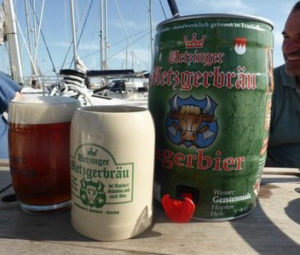Wheat beer, also known as “Weißbier”, is among the most traditional and versatile beer styles in Germany. With its characteristic yeast notes, cloudy appearance, and fruity-fresh aroma, it has secured a permanent spot in beer gardens and on refrigerated shelves. While it is deeply rooted in Bavarian culture, its popularity now extends far beyond Germany’s borders. This article delves into the history, production, various styles, and current market trends of wheat beer—a true revenue generator, not just in Bavaria!
History: From Bread Grain to Beer Delight

A glass of “Weißbier” (wheat beer) refreshes the soul in a summer beer garden (Bildquelle: AdobeStock_91009538)
Wheat beer boasts centuries of tradition. As far back as the Middle Ages, wheat was used as a brewing ingredient, though its production was long reserved for the nobility. This exclusivity stemmed from the “wheat beer monopoly” established in Bavaria during the 16th century. Only the Wittelsbach family could brew wheat beer, as wheat was considered a precious resource primarily designated for bread-making.
This monopoly made wheat beer a luxury item affordable only to the wealthy. It wasn’t until the 19th century, with industrialization and relaxed brewing regulations, that wheat beer became accessible to the general population. The Schneider family, in particular, championed the renaissance of wheat beer, bringing it back to Bavarian taverns.
Today, wheat beer represents not only tradition but also innovation. Modern versions, such as non-alcoholic wheat beers or creative fruit blends, cater to a broad audience.
Production: More Than Just Wheat and Water

Wheat beer: Offers a taste of Bavaria beyond its borders (Bildquelle: AdobeStock_329301768)
Wheat beer is crafted through a unique brewing process. As its name suggests, its primary ingredient is wheat malt. According to the German Purity Law, at least 50% of the malt composition must be wheat, although higher percentages are common to emphasize the beer’s lightness and fruity notes.
The hallmark of wheat beer production lies in the yeast. Most wheat beers use top-fermenting yeast, which operates at higher temperatures (between 59°F and 68°F or 15 und 20 °C). This yeast imparts the beer’s signature banana, clove, and occasionally vanilla flavors. It also causes the yeast to rise to the top during fermentation, creating a white froth that inspired the name Weißbier (literally “white beer”). Wheat beers are lightly hopped, making them less bitter than beers like pilsners.
Another distinguishing feature is bottle fermentation. Many wheat beers undergo secondary fermentation in the bottle, resulting in fine carbonation and natural cloudiness. However, this makes storage and transport challenging, as the beer is sensitive to temperature fluctuations. For beverage retailers, careful storage and quick turnover are essential to maintain quality.
While bottle fermentation is common, some wheat beers are tank-fermented. The degree of yeast cloudiness varies among these beers, with some undergoing filtration to produce Kristallweizen—a clear, sparkling version nicknamed “champagne wheat beer” (Champagner-Weizen) for its effervescence and appearance. However, this style has become less common and is influenced heavily by regional preferences.
Wheat Beer in Minikegs– A Revenue Driver
Wheat beer and mini kegs—a partnership with great potential. While wheat beer is celebrated worldwide for its variety and tradition, the mini keg offers functionality and a premium appeal. Especially in export markets, mini kegs drive sales by delivering German brewing quality, showcasing exclusive branding on a large surface, and providing a social drinking experience that resonates globally.

Brands like Paulaner have demonstrated that this combination works particularly well in Asia and other high-growth markets. The concept of “sharing with friends and family” is especially popular on the Asian continent, and 5-liter kegs are ideal for this. They embody the ethos of self-tapping, sharing, and toasting together. Wheat beer, a quintessentially German product, is even marketed under export-only brands, such as Höfjäger, which Denninghoffs GmbH sells primarily in South America.
Wheat Beer Varieties: Something for Every Taste
Wheat beer comes in a wide array of styles, ranging from classic to modern:
- “Hefeweizen” beer: The quintessential wheat beer. Cloudy, fruity, and refreshing—a beer garden favorite.
- “Kristallweizen” beer: A filtered wheat beer with a clear appearance and milder taste, often chosen for festive occasions.
- “Dunkles Weizenbier” (Dark Wheat beer): Brewed with darker malts, giving it caramel and chocolate notes.
- “Weizenbock” (Wheat bock beer): A stronger version with higher alcohol content and richer flavors, ideal for colder months.
- Non-Alcoholic Wheat Beer: A popular choice for health-conscious consumers, retaining the traditional taste thanks to modern brewing techniques.
- Fruit Wheat Beer: Innovative and experimental—wheat beers infused with fruits like lemon or raspberry appeal particularly to younger audiences.
Market Trends: Opportunities and Challenges for Breweries and Retailers

Despite a slight decline in overall beer consumption in Germany, wheat beer remains a stable market player. After pilsner and lager, wheat beer consistently ranks as the third most-consumed beer in Germany. Non-alcoholic varieties are experiencing a significant boom, with studies showing that one in three non-alcoholic beers sold in Germany is a wheat beer.
Another notable trend is regionality. Consumers are increasingly valuing beers from their local area, creating opportunities for small and medium-sized breweries. In export markets, wheat beer also holds a strong position—particularly in the United States and Asia, where German brewing tradition is highly regarded.
For beverage retailers, this means demand for wheat beer remains steady, but managing the product range is becoming more complex. To stay competitive, they must offer both classic styles and trendy options like non-alcoholic or regional wheat beers. Nonetheless, wheat beer continues to be a reliable revenue driver—well beyond Bavaria!
Picture Source Titelpicture: AdobeStock_91009538



